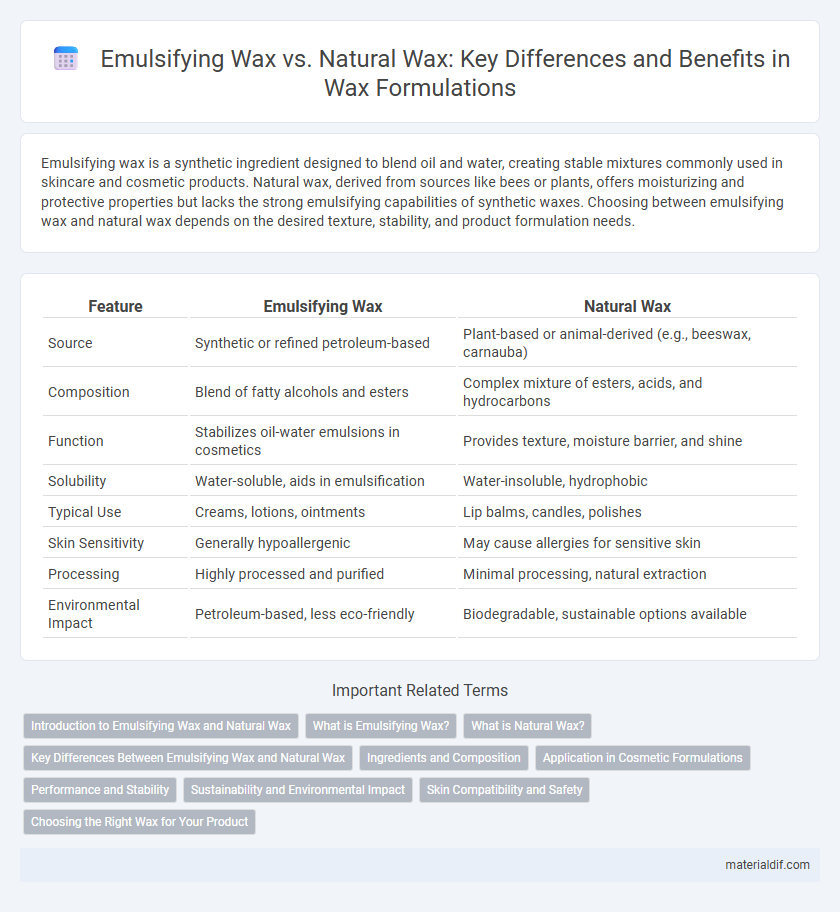Emulsifying wax is a synthetic ingredient designed to blend oil and water, creating stable mixtures commonly used in skincare and cosmetic products. Natural wax, derived from sources like bees or plants, offers moisturizing and protective properties but lacks the strong emulsifying capabilities of synthetic waxes. Choosing between emulsifying wax and natural wax depends on the desired texture, stability, and product formulation needs.
Table of Comparison
| Feature | Emulsifying Wax | Natural Wax |
|---|---|---|
| Source | Synthetic or refined petroleum-based | Plant-based or animal-derived (e.g., beeswax, carnauba) |
| Composition | Blend of fatty alcohols and esters | Complex mixture of esters, acids, and hydrocarbons |
| Function | Stabilizes oil-water emulsions in cosmetics | Provides texture, moisture barrier, and shine |
| Solubility | Water-soluble, aids in emulsification | Water-insoluble, hydrophobic |
| Typical Use | Creams, lotions, ointments | Lip balms, candles, polishes |
| Skin Sensitivity | Generally hypoallergenic | May cause allergies for sensitive skin |
| Processing | Highly processed and purified | Minimal processing, natural extraction |
| Environmental Impact | Petroleum-based, less eco-friendly | Biodegradable, sustainable options available |
Introduction to Emulsifying Wax and Natural Wax
Emulsifying wax is a synthetic or semi-synthetic ingredient designed to blend water and oil components in cosmetic formulations, creating stable emulsions used in creams and lotions. Natural wax, derived from plant or animal sources like beeswax or carnauba wax, offers moisturizing and protective properties with inherent biodegradability and skin-friendly benefits. Understanding the chemical composition and functionality of emulsifying wax versus natural wax is essential for selecting appropriate ingredients in skincare product development.
What is Emulsifying Wax?
Emulsifying wax is a specially formulated ingredient designed to blend oil and water components in cosmetic and skincare products, creating stable emulsions that prevent separation. Unlike natural waxes derived directly from plants or animals, emulsifying wax undergoes chemical processing to enhance its ability to bind differing substances effectively. This versatile wax is essential in lotions, creams, and other formulations where smooth texture and consistent appearance are critical.
What is Natural Wax?
Natural wax is derived from plant, animal, or mineral sources such as beeswax, candelilla, and carnauba, offering eco-friendly and biodegradable alternatives to synthetic options. It retains natural properties like moisturizing and protective benefits, making it ideal for skincare formulations and cosmetics. Unlike emulsifying wax, which contains added emulsifiers to blend oil and water, natural waxes require additional agents to create stable emulsions in product formulations.
Key Differences Between Emulsifying Wax and Natural Wax
Emulsifying wax is a synthetic compound designed to blend oil and water to create stable creams and lotions, featuring consistent melting points and enhanced skin compatibility. Natural waxes, such as beeswax or carnauba, are derived from plant or insect sources, offering nourishing properties and characteristic scents but lacking the emulsifying capacity. The key difference lies in emulsifying wax's ability to form stable emulsions, whereas natural wax primarily acts as a thickener or protective barrier without combining oil and water phases effectively.
Ingredients and Composition
Emulsifying wax is a synthetic blend primarily composed of fatty alcohols and surfactants, designed to combine oil and water phases in cosmetic formulations. Natural waxes, such as beeswax or carnauba wax, consist mainly of long-chain hydrocarbons, esters, and fatty acids, offering more occlusive and moisturizing properties. The choice between emulsifying wax and natural wax depends on formulation goals, with emulsifying wax enhancing stability and natural wax providing texture and hydration.
Application in Cosmetic Formulations
Emulsifying wax is widely used in cosmetic formulations to create stable oil-in-water emulsions, enhancing the texture and consistency of creams and lotions. Natural waxes like beeswax provide emollient properties and contribute to the thickening and water resistance of skincare products, promoting skin hydration and protection. Combining emulsifying wax with natural waxes allows formulators to achieve balanced stability and sensory attributes tailored to specific cosmetic applications.
Performance and Stability
Emulsifying wax offers superior stability in formulations by effectively combining oil and water phases, resulting in consistent texture and enhanced shelf life. Natural waxes, such as beeswax or carnauba, provide excellent emollient properties but may exhibit variable performance due to natural composition differences. The choice between emulsifying and natural waxes significantly impacts product stability and texture in cosmetic and skincare applications.
Sustainability and Environmental Impact
Emulsifying wax, often synthetic or derived from petrochemicals, tends to have a larger carbon footprint and slower biodegradability compared to natural waxes like beeswax or soy wax, which are renewable and biodegradable. Natural waxes are sourced from plants or animals, promoting sustainability through renewable harvesting and reduced reliance on fossil fuels. Choosing natural waxes supports lower environmental impact with fewer chemical additives and enhances ecosystem preservation by minimizing pollution.
Skin Compatibility and Safety
Emulsifying wax, a synthetic compound commonly derived from petroleum or vegetable oils, offers consistent texture and stability but may cause irritation in sensitive skin due to chemical additives. Natural waxes such as beeswax and candelilla wax provide superior skin compatibility by containing beneficial fatty acids and antioxidants that nourish and protect the skin barrier. Skin safety profiles favor natural waxes because they are less likely to trigger allergic reactions or clog pores, promoting healthier and more balanced skin.
Choosing the Right Wax for Your Product
Choosing the right wax for your product depends on the desired texture, melting point, and source material. Emulsifying wax, derived from synthetic or plant-based components, provides excellent stability and easy blending in creams and lotions, ensuring consistent emulsification. Natural waxes like beeswax and carnauba offer organic benefits and unique hardness but may require specific formulations to achieve optimal product performance.
Emulsifying wax vs Natural wax Infographic

 materialdif.com
materialdif.com